14+ Sample Quality Agreements
-
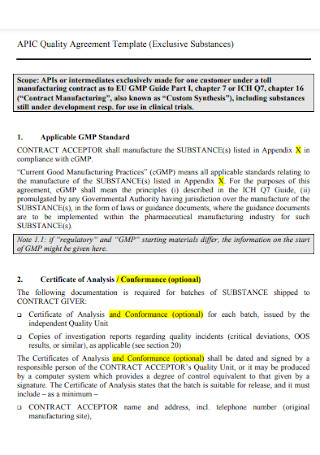
Quality Agreement Template
download now -

Supplier Quality Agreement
download now -
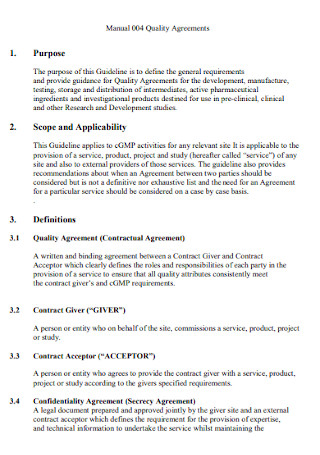
Manual Quality Agreements
download now -
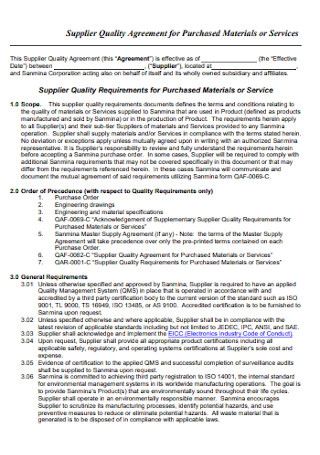
Quality Agreement for Purchased Material
download now -
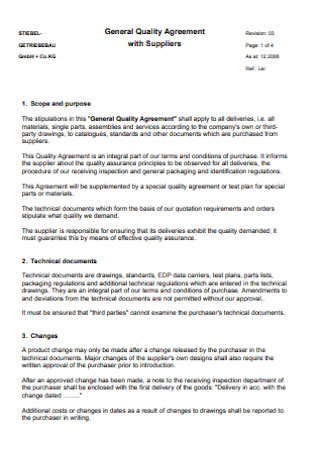
General Quality Agreement
download now -
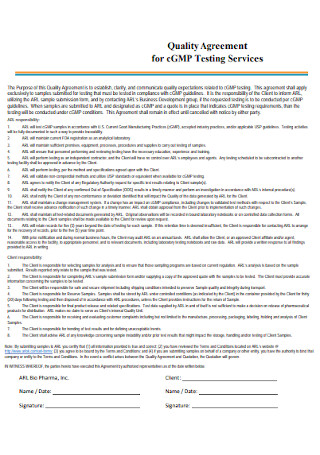
Quality Agreement for Testing Services
download now -
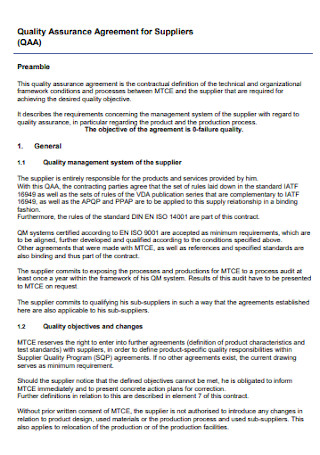
Quality Assurance Agreement for Suppliers
download now -
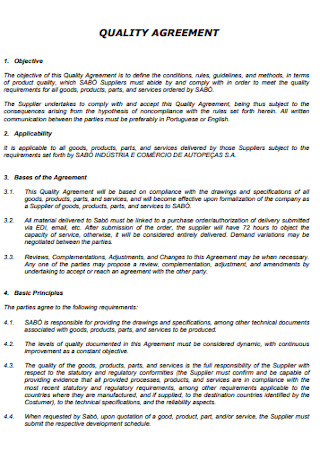
Simple Quality Agreement
download now -
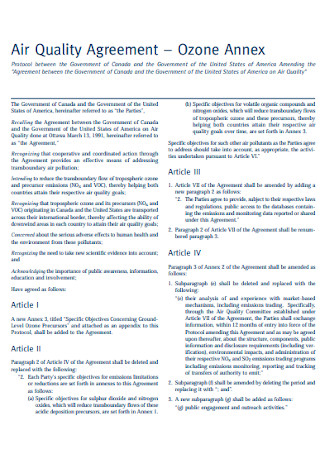
Air Quality Agreement
download now -
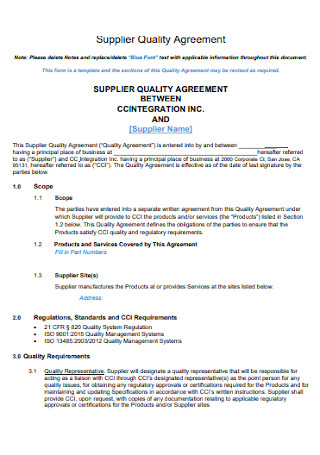
Sample Supplier Quality Agreement
download now -
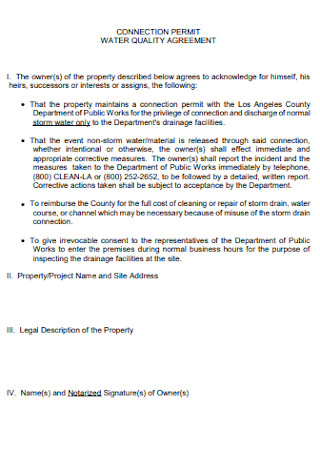
Water Quality Agreement
download now -
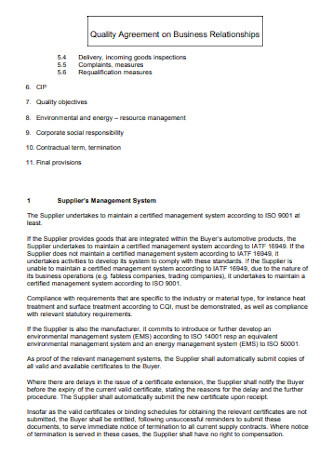
Quality Agreement on Business Relationship
download now -
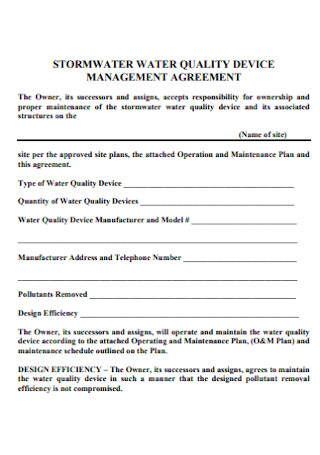
Stormwater Quality Agreement
download now -
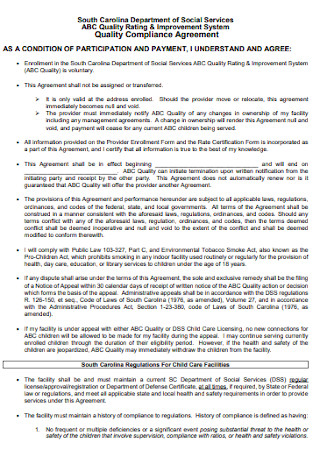
Quality Compliance Agreement
download now -
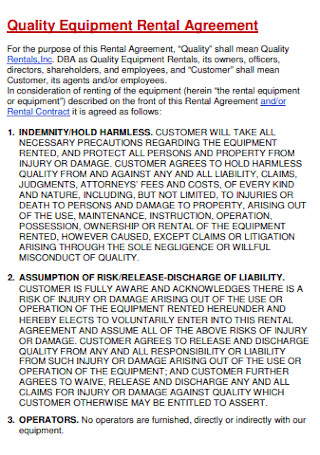
Quality Equipment Rental Agreement
download now
FREE Quality Agreement s to Download
14+ Sample Quality Agreements
What is a Quality Agreement?
When is a Quality Agreement Needed?
Regulatory Requirements of a Quality Agreement
What are the Different Types of Quality Agreements?
Why Do We Need a Quality Agreement?
What Should Be Included In a Quality Agreement?
How to Write a Quality Agreement
Auditing in a Quality Agreement
FAQs
Where is a Quality Agreement Needed?
What are the qualities of a great quality agreement?
What should be excluded in writing a quality agreement?
What is a Quality Agreement?
By definition, a quality agreement is a legally-binding document that clearly states the specific quality parameters of a certain project and which party is responsible for bringing the said parameters into action. The intent of having a quality agreement is to reduce the internal frustration of being told what to do without the input of a sponsor and also helps avoid the possibility of not living up to expectations. The level of detail inside a quality agreement will vary depending on the project’s developmental stage. It should be noted, however, that a quality agreement is not the same as a business agreement that covers the commercial terms and conditions that a contract contains. A quality agreement is merely prepared by quality personnel and only focuses on the quality of the service being provided.
When is a Quality Agreement Needed?
Every time a contractor is called into service or the services of a contract manufacturing organization (CMO) is to be used, a quality agreement is to be used. Here are some situations that necessitate a quality agreement:
- API Supplier
- Excipient Supplier
- Contract Packaging Facility
- Contract Stability Storage Facility
- Contract Testing Facility
- Contract Research Organization
- Warehousing Arrangement
Regulatory Requirements of a Quality Agreement
Having a quality agreement is not just down to a matter of keeping good business practice. In fact, there are also regulatory requirements of a quality agreement. The requirements of a quality agreement indicate the following critical activities that must be done:
- It must assess the suitability and the competence of potential contractors prior to outsourcing operations or selecting material suppliers. This can be done via an investigative questionnaire method, audits, or evaluations.
- It should define the manufacturing responsibilities and communication processes for quality-related activities of the parties involved. This can be done by including all outsourced activities in the agreement document.
- It must monitor and review the performance of the contract facility and also identify and implement any needed improvements.
- It should also monitor incoming raw materials to make sure that they are from the approved sources that used the supply chain that is agreed upon.
What are the Different Types of Quality Agreements?
There are four different types of quality agreements, and each of them is tailored to cater to the needs of a specific type of relationship. Here are those:
Why Do We Need a Quality Agreement?
The simplest reason on why we need a quality agreement document is to manage the expectations of the two parties involved in the agreement from the perspective of the quality of work that is to be provided and their compliance with the regulations that are in place. Any outsourced activity that is covered by the Good Manufacturing Process (GMP) that is guidelines should be clearly and concisely defined, agreed upon, and controlled in order to prevent any misunderstandings between the parties involved which can lead to products created or services rendered that are of subpar quality.
What Should Be Included In a Quality Agreement?
Here are the critical areas that should be covered when writing an effective quality agreement:
How to Write a Quality Agreement
An effective quality agreement has standard procedures in place to indicate the types of vendors and services that will require the said document. As it is being written, nothing should be taken for granted and both parties should review it to ensure that their requirements are included. With that being said, here are the steps that you can follow in order to write a quality agreement:
1. Identify the parties involved in the agreement.
In a quality agreement, the parties involved are the quality assurance coordinator, the head of the laboratory from the main sponsor and the corresponding individual from the contract company, and the auditor from the sponsor company for routine assessment of the contract company. It is also important to identify the roles of the parties involved in the quality agreement, which can be done via the use of the RACI (responsible, accountable, consulted, and informed) matrix method:
- Responsible – the person/group of people who performs a given task. As stated, responsibilities can be shared between one or more individuals.
- Accountable – this defines the single individual who is accountable for the work that is being done. Even though the responsibilities of a certain task can be distributed among the members of a team, only one person is considered to be accountable for it.
- Consulted – this refers to the people who are asked for advice, therefore consulted, before the task is performed or during the performing of the task.
- Informed – this refers to the people who are informed/notified once the task being worked on has been completed.
2. Write down the essential elements of the quality agreement.
In this step, begin writing down the main body of the agreement, along with its essential information. It is important to keep in mind that a quality agreement should be describing and acknowledging the responsibilities of the parties involved, terms of collaboration, the scope of the project in the agreement, the terms concerning the materials management, the activities to be performed, the product-specific considerations, the change control and revisions, and the terms regarding the documentation of the activities that are performed throughout the timeline of the agreement.
3. Write down the elements/clauses that can be used in case something goes wrong.
An essential part of the quality agreement (or any agreement) is also writing down the elements or clauses that can be referenced by all parties involved in case something goes awfully wrong throughout the project. The elements refer to the following: Terms Regarding Insurance or indemnification, guidelines to be used for resolving disputes, coverages in case any individual gets injured while doing activities that relate to the agreement, grounds for terminating the ongoing agreement or contract, and the terms to be referenced for possible amendment of the terms listed in the agreement or contract.
4. Verify the document.
In this step, it is important to go through the agreement once or multiple times and give it a proper verification process after producing your initial draft. Make sure that nothing of importance is left out, and nothing unnecessary to the agreement or project is included in the document. The process of editing and proofreading consists of the examination of the entire material, structure, clarity, and style. It is important to review the document for the purpose of monitoring, adverse event reporting, accountability purposes, and checking for negotiable terms or clauses. It is also recommended that you submit the paper over to a legal professional for evaluation after thorough rewriting and editing. It is always advisable to seek a legal professional’s advice to help you find ways to produce effective and legal documents.
Auditing in a Quality Agreement
The role of auditing in a quality agreement is essential because it confirms that a contract company can work with a suitable quality system. With that being said, auditing comes in three different types, which are the following:
FAQs
Where is a Quality Agreement Needed?
These documents are not only needed between contractors that operate in a different regulatory environment. In fact, a quality agreement is also needed during any outsourcing agreement between different divisions of the same company, regardless of where they are located. Whenever a business is to be done in a different state or region, it is good standard practice to have an effective quality agreement in place regardless if it is required or not.
What are the qualities of a great quality agreement?
Here are the qualities that make up a great quality agreement:
- It clearly lays out who is responsible for which aspects of the statement of work, whether it should be the contract giver or the client
- It specifies time windows for review of documents, reporting of deviations, notifications, and audits, and it also specifies business or calendar days.
- It contains a clear and concise definitions section which in turn leaves little to no room for interpretation. For example, it should specify the difference between a critical, major, or minor deviation.
- A great quality agreement describes a way or a mechanism for amending the terms contained inside it, if absolutely necessary.
- It should describe exactly the things that will be delivered and the tasks that will be performed.
What should be excluded in writing a quality agreement?
There are also items that should be excluded whenever a quality agreement is being made. Here are those items:
- General business terms and conditions
- Pricing clauses
- Delivery terms
- Confidentiality obligations
- Liability Limitations
The items that are listed above do not belong in a quality agreement. Instead, they should be listed in a separate document called a supply agreement.
In conclusion, having a well-written quality agreement is essential because it allows the parties involved to define their expectations and rules governing projects and ensures that their quality attributes align with each other. It also saves a great amount of money and time by preventing any kind of misunderstanding between all parties from happening. It also helps them in the overall process of contract analysis. In this article, examples of a well-written quality agreement are provided above so that you can have something to use as a reference in case you want to write one yourself.
